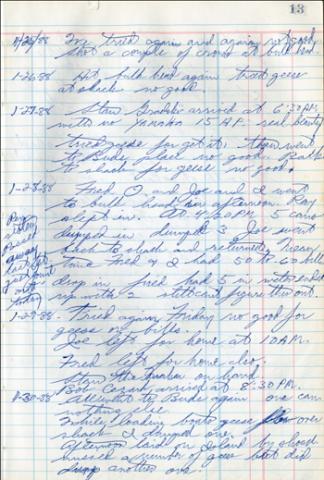
Oral History Interview with John Magnus and Ray Millek
Transcript of Audio
Nancy: How old were you the first time you went hunting?
John Magnus: Five.
Nancy: And do you remember what happened?
JM: I remember being there. That’s what I said—crippled a teal, it was in the water, and I swam underwater—actually a bird when he’s underwater will open his wings and use his wings to actually fly underwater—
Ray Milek: Propels himself, yeah, he’ll push himself—
JM: Yeah, propels. He goes like a son-of-a-gun. Ooh, they can move. You shoot a Sheldrake and you see how—he’ll go 60 yards away from you when he comes up, he’ll go down, come up 60 yards away and that’s a long way off. But broadbill’s the same way. Any bird that’s crippled, [unknown], they’ll die [unknown], which in a cripple they’ll also die and swim underwater. Geese, everything. They all will.
RM: Well, when we had that freeze up there, what was it, about five, six years ago? Seven years ago, the black ducks were feeding on the bridge pilings down there in deep water.
JM: Oh yeah, on one of them bridges. They feed on the black mussels.
RM: Which, normally they’re tip-up ducks. They generally feed in shallow water.
JM: They’re vegetarian, normally, so—
RM: But they were feeding on mussels—
JM: They’ll take anything, killies, anything they can get.
Nancy: Is that why they’re a fishy bird, a lot of people—
JM: No, basically there are black duck, mallard, all these birds are grain eaters—pintail and like that, widgeon, gadwall, they will eat grain, rice, whatever they can find.
Nancy: And those are all birds that are found around here.
JM & RM: Yeah.
JM: But basically, when you have a real severe winter they either starve or they gotta, they’ll eat snails, they’ll eat killies, spearing, anything they can get and then they come fishing.
RM: Well, most of them will pick up and get going. They’ll go down south.
JM: Yeah, usually they’ll migrate further south where it’s not as severe.
RM: We’ve had ‘em where the freeze comin’ overnight and everything locked right up and they couldn’t get any feed. They’re stuck. Because a bird, you know, he’s got to eat, they’re eating constantly and if he’s stuck overnight, he’s got to eat before he can take off and go anywhere. So if they’re locked in with ice they’re stuck. But I saw a brant frozen into Milburn Creek up in here, all frozen right into the ice. Overnight, they froze—
JM: That one year they died by the hundreds. In fact I dumped a ton of—
Nancy: When was this?
JM: Seven years ago, wasn’t it? Eight years ago?
RM: About seven or eight years ago.
JM: I know I dumped, myself, in a week and a half I dumped over a ton of corn. I had just regular spots where the birds were tending, you know? They were all in the water I go down, I dumped a hundred pounds, a hundred and fifty pounds, I had seven . . . nine spots I was feeding, did that on the weekend. I’d do it during the week, too, on my lunch hour, take my truck—
RM: Well that was the Great South Bay Water Fowl Association, they bought the corn. They spread 40 tons of corn.
JM: There was a lot of donations involved. They asked for donations and people were sending, $5, $10, $15 in for corn. They were buying corn by the truckload from New Jersey. But a lot of birds survived because of it, otherwise they never would have survived. [Unknown] they were feeding down this end, George Cones was feeding in Massapequa, you were feeding here in Baldwin, I believe—
RM: Yeah, Baldwin in Milburn and the pond—
JM: And I was feeding from Lindenhurst, Amityville/Lindenhurst area all the way out to Patchogue, I was. I had about nine spots I fed.


